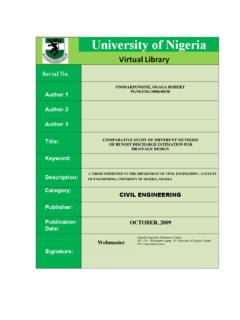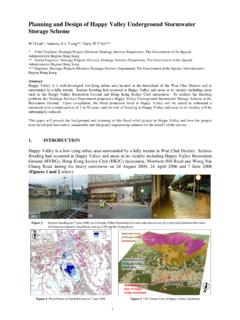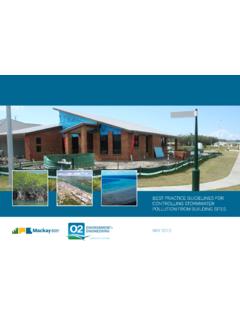Transcription of Water Conveyance Systems and Flood Control Works
1 UNESCO EOLSSSAMPLE CHAPTERSHYDRAULIC STRUCTURES, EQUIPMENT AND Water DATA ACQUISITION Systems Vol. II - Water Conveyance Systems and Flood Control Works - Jordaan Encyclopedia of Life Support Systems (EOLSS) Water Conveyance Systems AND Flood Control Works Jordaan Pr. Eng., Box 40035, Arcadia 0007, Pretoria, South Africa Keywords: Flood Control , Water Conveyance , contingency planning, canals, pipelines, dams, spillways, river training, hydraulic structures, hydrology, Flood warning, risk analysis, canal design, cross drainage Contents 1. Introduction 2. Water Conveyance Systems : Canal Design Capacity Gradients and Head Losses Design of Canals for Water Conveyance 3. Water Conveyance Systems : Design of Pipelines and Other Closed Conduits Theory of Pipe Flow Conveyances Theory Considerations 4. Flow Measurements 5. Concluding Remarks Concerning Water Conveyances 6. Design of Flow Control Works Considerations Features and Details of Flood Control Dams Spillways Crest Gates Gated Outlets for Draw-down Purposes Gated Outlets for Draw-down Purposes of Operation of Flood Control Dams Flood Absorption Pre-release Types of Flood Control Systems and Mechanisms Breaching-section Siphon Spillway Fuse Gates Considerations Regarding Flood Control by Means of Artificial Structures Dam-break Generated Flood Waves Flood Plain Detention High Run-off Areas 7.
2 River Confinement Techniques, Devices, Secondary Effects and Maintenance UNESCO EOLSSSAMPLE CHAPTERSHYDRAULIC STRUCTURES, EQUIPMENT AND Water DATA ACQUISITION Systems Vol. II - Water Conveyance Systems and Flood Control Works - Jordaan Encyclopedia of Life Support Systems (EOLSS) Channels, Cutoffs , Channel Improvement Functioning Measures Maintenance Erosion and Sedimentation 8. Some Examples of Flood Control Structures 9. Conclusions Regarding Flood Control Structures and Measures 10. Flood Monitoring and Contingency Planning Guidelines Background Hydrological Analysis of Extreme floods Recorded Analysis Index Warning Stations and Monitoring Observations at Early Warning Stations in the Drainage Area Network Systems Methods of Flood Management Criteria Measures 11. Flood Predictions and Warning Criteria 12. Flood Effect Mitigation and Manipulation 13. Flood Contingency Management 14. Conclusion Glossary Bibliography Biographical Sketch Summary In this article dealing with applied hydraulics and design of Water Control structures, two aspects are described.
3 Firstly, the orderly Control and conduction of Water through conveyances such as canals and pipelines from source to user area. Secondly, the mitigation of the effects of extreme flooding events by judicious provision and operation of Flood Control structures. 1. Introduction Applied hydraulics involves the design of Water Conveyance Systems and Flood Control Works . In the first case, Water Conveyance , the objective is to provide the desired through-put from the source to the user area in an orderly, controlled manner. In the latter case, Flood Control , the aim is to develop and optimum strategy of Control against an unpredictable adversary. The impacts of floods which are uncontrolled are awesome, as happened not long ago, during the 1960's, when the river Arno flooded a large part of the city of Florence, Italy, due to the sudden opening of Control gates to release an oncoming Flood .
4 In 1981 the town of Laingsburg in the arid Little Karoo of South Africa was devastated by a flash Flood originating over three sub-catchments and concentrating the effects at the junction of three rivers, exactly where the town is situated. No Control was possible, UNESCO EOLSSSAMPLE CHAPTERSHYDRAULIC STRUCTURES, EQUIPMENT AND Water DATA ACQUISITION Systems Vol. II - Water Conveyance Systems and Flood Control Works - Jordaan Encyclopedia of Life Support Systems (EOLSS) but the devastated area was eventually converted into a landscaped park to avoid the recurrence of loss of life and damage. In the case of the city of Los Angeles, frequently visited in the past by flash floods from the Santa Ana Mountains, a well-engineered Flood detention and containment system was developed, to reduce the impact of such floods . Water consumption points are usually situated at great distances from Water supply sources.
5 To cover these distances Water Conveyance Systems are utilized. These may consist of free surface or enclosed pressure conduits, open canals, tunnels, gravity pipelines, pumping mains and penstocks. Typical examples are: a dam forming a raw Water storage reservoir, supplying a canal to an irrigation project, or a bored Water well-field feeding a clean Water reservoir, connected by pipeline to a domestic Water distribution system . In free-surface flow channels and canals, as well as closed conduits, the minimization of friction losses is very important, especially where the distances of Conveyance become very large (tens to hundreds of kilometers). Special hydraulic structures are also involved, inverted siphons, hydraulic tunnels, inlet and outlet Works , junctions and fittings in conduits. In the hydraulic design of these flow structures, reliance is made on hydraulic principles and economics.
6 The lower the hydraulic resistance is to be made, the larger the structure's cross-section becomes, and the more expensive the capital investment, but lower the energy cost, to operate it. To derive an optimum balance between usefulness and operating cost is the aim of the design engineer. Considering briefly some aspects of economic design of canals, pipelines and related hydraulic structures, such as tunnels, inverted siphons, intake and outlet Works , flow dividers and distribution networks, is the aim of this article. The layout of drainage/sewerage Systems , such as municipal storm Water and waste disposal engineering is a further field of application of open and closed conduit flow. The basic theory of Control of free-surface and closed conduit flow is contained in textbooks and postgraduate courses, with its applications dealt with in hydraulic design practice manuals and speciality courses, as well as in another article in this theme (see Elements of Control Systems ).
7 In the following sections a number of guiding principles are presented relating to the design and management of canals and closed conduits, as well as Flood Control Works . 2. Water Conveyance Systems : Canal Design Before dealing with the design of canals for Water Conveyance a few fundamental principles are reviewed. Much of this information is available in standard hydraulic textbooks, and therefore only a brief review of the main criteria is presented here. UNESCO EOLSSSAMPLE CHAPTERSHYDRAULIC STRUCTURES, EQUIPMENT AND Water DATA ACQUISITION Systems Vol. II - Water Conveyance Systems and Flood Control Works - Jordaan Encyclopedia of Life Support Systems (EOLSS) Discharge Capacity Discharge capacity is determined by means of a head-loss gradient/discharge equation, such as Manning, Chezy or Hazen-Williams. Canals mostly comprise the conveyances of greater Water supply projects and must be visualized and designed in the total context of the project.
8 Canals are mainly utilized for transporting raw (untreated) Water , such as agricultural Water , as well as bulk Water supply for industrial and domestic use (see Measurement of Open Channel Flow). For smaller scale treated Water supply, especially for networks such as used in sprinkler irrigation, residential household and urban office block supplies, pipelines are used because they have a lower loss of quantity, higher supply pressure and elimination of contamination and require smaller servitude areas. At times a direct pipeline, tunnel or inverted siphon may be several times shorter, and therefore more economical, than a canal having to follow contours and grade lines over a much longer distance. It therefore depends on the terrain's relief, degree of existing building, road and street development, which optimum route to choose and whether canals or pipelines will be used and in what combination.
9 Gradients and Head Losses Canal gradients may be as low as 1 in 10 000 for very large discharges (around 100 m3/s) to 1 in 4000 for the usual main supply canals; to 1 in 1000 or steeper, for drainage canals coping with variable flows down to very small values (less than one cubic meter per second). Additional head losses are implicit because of: uneconomical (narrower) cross sections in steep cross-slope terrain; tunnels, inverted siphons, flumes; transverse and side-spilling weirs; bends and section changes; and take-off points. These head losses are calculated in terms of loss coefficients times velocity head. Aging can also reduce the canal's capacity due to increased losses on account of: roughening of lining (reinforced concrete); alignment changes of panels of lining; and sediment deposition and chemical, biological fouling. Sustaining the capacity of a canal therefore necessitates periodic maintenance and refurbishment.
10 Design of Canals for Water Conveyance The most economical canal cross-section is a shape into which a semi-circle may be placed, either a rectangle, a trapezium or a parabola. Hydraulic theory requires that the UNESCO EOLSSSAMPLE CHAPTERSHYDRAULIC STRUCTURES, EQUIPMENT AND Water DATA ACQUISITION Systems Vol. II - Water Conveyance Systems and Flood Control Works - Jordaan Encyclopedia of Life Support Systems (EOLSS) hydraulic radius (area divided by wetted perimeter) be a maximum. The available terrain, width and cross slope are further factors influencing the optimal choice of cross section. For example, a practical trapezoidal concrete-lined canal will have side slopes of 1:1 or 1 instead of the ideal, 60 with the horizontal. An earth canal will have side slopes even flatter: 1:2 or 1 In all cases freeboard must be added. Maneuvering room for excavating and lining machines, inspection roads and spoil banks on either side of the canal must be added to the top width, thus doubling or trebling the overall width.
















